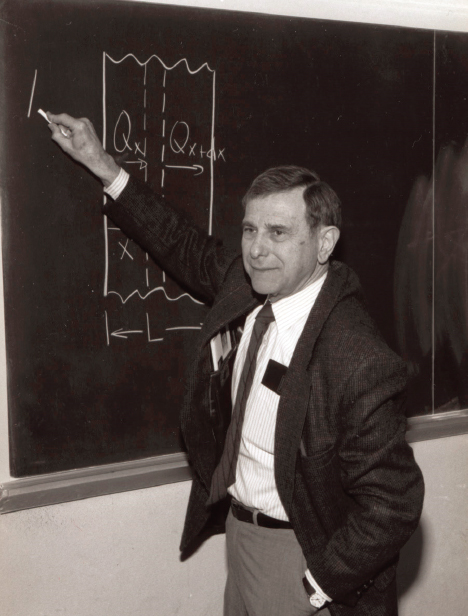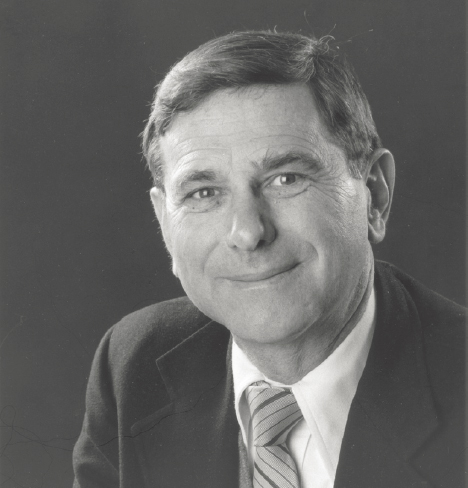

EPHRAIM M. SPARROW
1928–2019
Elected in 1986
“For outstanding, prodigious contributions to heat transfer through analysis and experimentation, and for superlative teaching.”
BY ROGER R. SCHMIDT, JOHN R. HOWELL, AND DAVID Y. PUI
EPHRAIM MAURICE SPARROW was an internationally recognized authority in heat transfer, considered by many the father of modern heat transfer. His work was characterized by impeccable quality and presented in over 850 peer-reviewed and widely cited technical papers that helped to set the standard of quality for an entire field. He passed away at age 91 on August 1, 2019.
Born in Bridgeport, Connecticut, on May 27, 1928, Eph was the son of Charles and Frieda (née Gottlieb) Sparrow. He received his BSc from MIT in 1948 at the age of 19, stayed to complete his MS in 1949, and then earned an MA and PhD at Harvard in 1950 and 1952, all in mechanical engineering. His PhD thesis was titled “Free Convection with Variable Properties and Variable Wall Temperature” under the supervision of Howard Emmons.
He began his professional career at Raytheon, working on a number of heat transfer problems including radar, the first microwave oven, and electronics cooling. Later he joined the National Advisory Committee for Aeronautics (NACA) at the Lewis Flight Propulsion Laboratory in Cleveland, where he worked on fluid mechanics and heat transfer. His many publications from his work at NACA (now NASA) included two papers in the first issue of the ASME Journal of Heat Transfer.
At NACA he began to appreciate and master the importance and skills of computation. He used to tell the story of how early numerical computations of boundary layer flows were done by rows of human “computers,” with each row representing a forward step in the marching integration process!
In 1959 he started his career at the Thermodynamics and Heat Transfer Laboratory in the Department of Mechanical Engineering at the University of Minnesota in Minneapolis. He was promoted to professor and served as the Fluid Mechanics Program chair (1968–80). He did a concurrent tour of duty at the National Science Foundation (1986–88, commuting back to the university on weekends to continue his work as professor of mechanical engineering), first as program manager for heat transfer (where he was notorious for calling tardy reviewers late at night to urge them to submit their reviews) and then as director of the Chemical, Bioengineering, Environmental, and Transport Systems Division in the Engineering Directorate.
His time at NSF, where he stressed the need to focus on practical problems and important fundamental issues, had a profound impact on his thinking. When he returned to the University of Minnesota, he followed his own advice, focusing on real-world engineering problems and leaving behind, to some extent, the world of academic problems. Companies flocked to him for advice, and he would help them all, asking little or nothing in return for his effort. He enjoyed applying his deep and broad knowledge to solve the toughest problems companies presented to him.
Over the years he worked actively in every facet of heat transfer and always at or near the frontiers of knowledge. His research included foundational studies in radiation heat transfer, turbulent flows in ducts, natural convection, film condensation, boundary layer flows with separation, laminar-turbulent transitions, force convective heat transfer with flow over objects, solid-liquid phase change problems, flow and heat transfer in porous media, inverse solutions, thermal optimization, biological heat transfer and fluid flow, development of new modeling techniques, cooling of electronic equipment, and many more. One of his favorite experimental tools was
the naphthalene sublimation technique, which allows very detailed measurements of local mass transfer coefficients. For many years, visitors to the mechanical engineering building got a strong whiff of that mothball smell!
He was unusual in his effectiveness in both experimentation and analysis/computation. He was among the first to recognize the enormous potential of the digital computer as a tool for solving highly complex problems in heat transfer and fluid flow. While he steadily produced analytical and computationally based research, he was perhaps best known as an innovative and painstaking experimentalist.
He was keenly focused on accurate and carefully controlled experiments. For example, when he wanted to perform some experiments for laminar flow at very high Reynolds numbers, he ran the experiments in the middle of night when traffic vibrations from the road outside his lab were minimized. Similarly, his wind tunnel work required so much electricity that he had to experiment on Sunday evenings when the load on the municipal electrical grid was sufficiently low to allow his power usage. For his convection experiments, he needed a room where the temperature was stable over days; he found one, with very thick walls and no windows, in the basement of the Aerospace Engineering and Mechanics Department and “borrowed” it.
As a classroom teacher, Professor Sparrow had no peer. He had an extraordinary ability to inspire, mesmerize, and convey complex materials in eloquently simple ways, simultaneously fostering in students an intellectual curiosity and a diligence that served them for life. His interactions with students also conveyed his devoted care and concern for them and their future. He supervised some 300 master’s and 100 doctoral degree students; many of the latter went on to become professors at well-known universities around the world.
Beyond the classroom and lab, he contributed significantly to the effective transmission of technical information. In 1979 he cofounded, with W.J. Minkowycz, the journal Numerical Heat Transfer as a forum for dissemination of ideas and research in the field of numerical heat transfer and computational
fluid dynamics; he chaired the editorial board. He was also a member of the editorial boards of the International Journal of Heat and Mass Transfer and of International Communications in Heat and Mass Transfer. He was editor of the ASME Journal of Heat Transfer for 8 years, during which it became one of the most prestigious publication vehicles in the field, with quality standards second to none. In recognition of his efforts he received the Distinguished Service Award from ASME’s Heat Transfer Division. He was also coeditor of a series of books on computational methods in mechanical and thermal sciences.
Professor Sparrow’s contributions were recognized by numerous honors and awards. In addition to his NAE election in 1986, he was a fellow of the American Society of Mechanical Engineers (1976) and received its Max Jakob Memorial Award (1976), Charles Russ Richards Memorial Award (1985), and Worcester Reed Warner Medal (1986). The American Society for Engineering Education selected him for the 1978 Ralph Coats Roe Award, and in 1993 Sigma Xi presented him with the Monie A. Ferst Award. He also received two teaching awards from the Institute of Technology of the University of Minnesota.
His contributions extended to international activities. In 1966 he headed a faculty team that established the first graduate programs in engineering in Brazil, resulting in his being awarded an honorary doctorate by the Pontifical Catholic University of Rio de Janeiro.
The deep affection for him among his colleagues, former students, and friends was captured in a tribute published in the February 2020 online issue of International Journal of Heat and Mass Transfer, a portion of which is captured here:
The numbers of researchers he has touched and whose research he has influenced are nearly uncountable…. Some of us met him early in his career, after he left the NACA Lewis Research Center in Cleveland and joined the faculty at the University of Minnesota in 1959. For others, the encounter was later, in the 1960s–1980s when he was at the height of his scientific productivity, publishing papers at an unbelievable rate. Yet others among us met him in the 1990s–2000s when his scholarly
interest had shifted to tackling challenging real-world problems. But regardless of our/your Eph story, it undoubtedly was marked by interactions with a kind, caring, charismatic mentor for sure, but first and foremost, a friend. Many of us have shared long, late-night hours with him working on projects or discussing deep issues of life. His most treasured word, possibly his guiding signpost, was “kindness.” He lived and breathed a deep affection and kindness to all—and we were all beneficiaries.
Eph was a self-proclaimed workaholic and spent many late nights and weekends on campus, often working with students on their experiments or helping them with their thesis. He continued to work right up to the end, completing several papers and theses in the last year of his life. At the time of his death, he was both the oldest and the longest-serving faculty member in the Mechanical Engineering Department.
He was survived by his beloved wife of 67 years, Ruth (née Saltman) and their daughter Rachel and her husband Satish. With both Ruth and Rachel, Eph’s teaching and research were a family affair—they helped proofread his journal papers before publication, and Ruth typed almost all of his 850 journal publications on their trusty IBM Selectric typewriter.
The greatest legacy anyone can leave behind is to positively impact the lives of others. Eph had a profound influence on so many of us, and our lives have been enriched tremendously by knowing him. We will greatly miss our mentor and friend.






